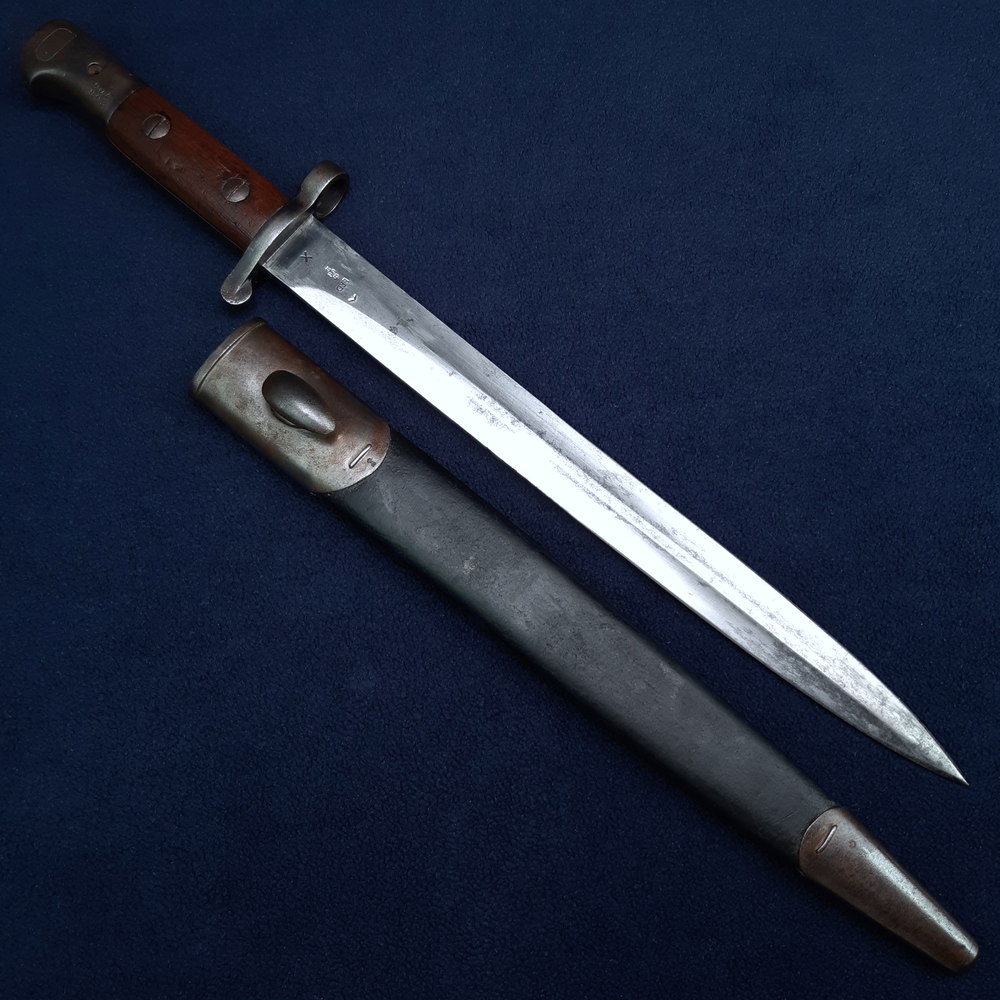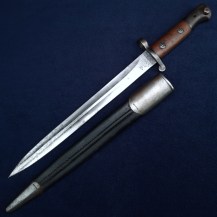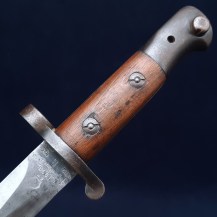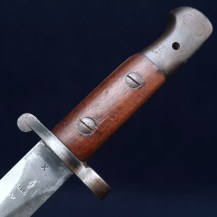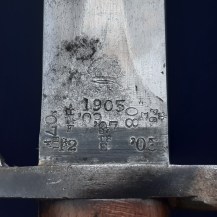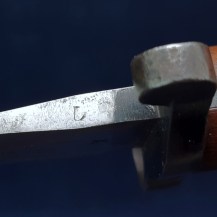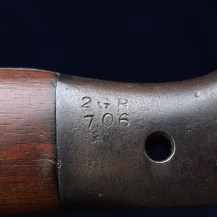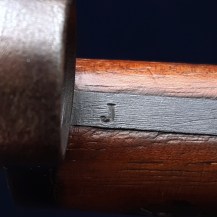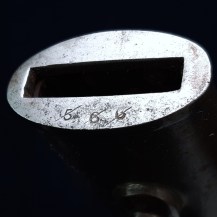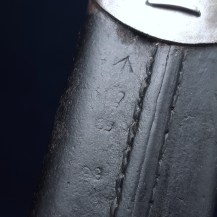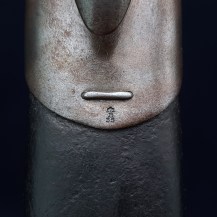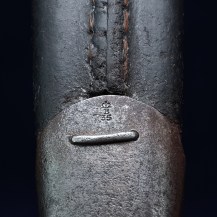British 1903 Pattern Bayonet, 2nd Battalion Gloucestershire Regiment
Spear pointed unfullered blade, wood scale grips secured with two screws. Steel beaked pommel with locking button and clearance hole, steel hilt with short quillon and muzzle ring. Black leather 1888 Mk I pattern scabbard with steel throat and chape pieces, throat piece with teardrop frog stud.
The blade is stamped on one side of the ricasso with a crowned ‘E.R.’, and 1903 (the pattern), a production date of 12 ’03, meaning December 1903, three crown inspection marks with ‘E’ for Enfield and reissue stamps ’07, ’07 (again), ‘08 and ’09. On the other side it is stamped with a broad arrow Ward Department mark, the maker’s mark ‘EFD’ for the Royal Small Arms Factory at Enfield, another crown inspection mark with ‘E’ and an ‘X’ which indicates that the blade passed a manufacturer’s bending test. The belly of the blade is faintly stamped with ‘D’.
The pommel is stamped with ‘2GR’ over ‘706’. This indicates that this was bayonet number 706 used by the 2nd Battalion, The Gloucestershire Regiment.
The exposed tang is stamped with ‘J’. The throat piece of the scabbard is stamped at the mouth with ‘566’, each digit later cancelled with a strikethrough. The leather of the scabbard is stamped next to the seam with another broad arrow, another crown inspection stamp and the manufacture date ’99. The throat and chape pieces are stamped next to the staples with small crown inspection stamps with ‘B’ for Birmingham.
The 2nd Battalion Gloucestershire Regiment was originally the 61st (South Gloucestershire) Regiment of Foot, which merged with the 28th (North Gloucestershire) Regiment of Foot in 1881 to form the Gloucestershire Regiment as part of the Childers Reforms. It fought in South Africa in the Second Boer War from 1900, taking part in the Battle of Paardeberg then being deployed to the Bloemfontein area until it returned to England in 1904, after which it would have been reequipped with the new SMLE and bayonet.
The 1903 Pattern bayonet had quite a short service life with the SMLE rifle: it was judged to be too short compared to other armies’ bayonets which would be a disadvantage in bayonet combat, so the 1907 Pattern was designed and produced in much larger quantities to replace it. As a regular infantry unit the Gloucestershire Regiment was probably issued with the 1907 Pattern relatively quickly – the next deployment of the 2nd Battalion overseas was not until 1910 so their 1903s were probably put aside without having seen action.
The battalion was stationed at the treaty port of Tientsin in China at the outbreak of WW1 and returned to fight at Ypres and later in Bulgaria, Armenia and Russia. The 1st and 2nd battalions were amalgamated in 1948. In 1994 the one-battalion regiment was merged with the Duke of Edinburgh's Royal Regiment (Berkshire and Wiltshire) to form the Royal Gloucestershire, Berkshire and Wiltshire Regiment. This was merged with three other regiments to form The Rifles in 2007, its lineage maintained today by 1st Battalion, The Rifles.
The blade is bright with patches of light patination increasing towards the tip, no edge damage. The ricasso of the blade retains its original band of bluing, slightly rubbed. The hilt, exposed tang and pommel also have a blued finish, with some wear to this in places on the hilt revealing lightly patinated steel. The scabbard pieces have moderate patination, some very light pitting near the tip of the chape on one side. The wood grips have only a few small dents, small chips next to one of the rivets on one side. The scabbard leather is good and flexible with only light rubbing wear, some dents on its edge, a few small cracks on the lip of the seam but all of its stitching remains intact.

